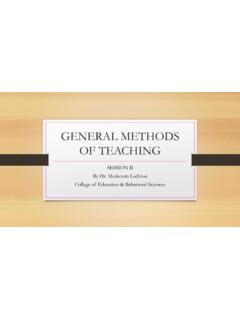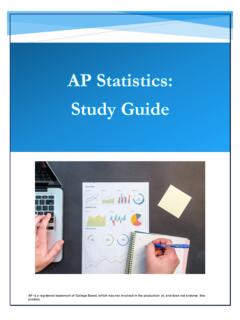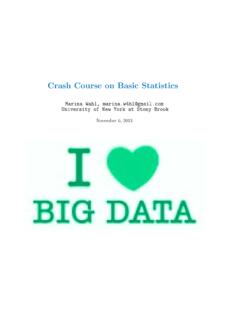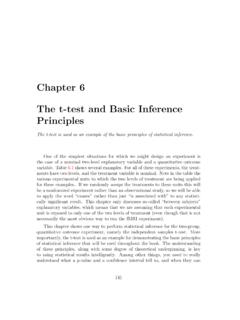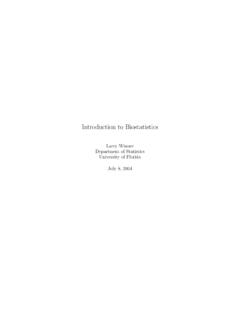Transcription of Basics of Statistics - School Learning Resources
1 Basics of StatisticsJarkko IsotaloBirthweights of children during years Dev = Mean = = to Accelerate from 0 to 60 mph (sec)30201001 PrefaceThese lecture notes have been used at Basics of Statistics course held in Uni-versity of Tampere, Finland. These notes are heavily based on the , A. & Finlay, B.,Statistical Methods for the Social Sci-ences, 3th Edition. Prentice Hall, , T. W. & Sclove, S. L.,Introductory Statistical Mifflin Company, , & Cooke, D.,A Basic course in , Statistics Textbook, , ,Modern elementary , , & Bhattacharyya, , Statistics : Principles andMethods,2nd Edition. Wiley, l , R.,Ohjeita tilastollisen tutkimuksen toteuttamiseksi SPSSfor Windows -ohjelmiston avulla, Tampereen yliopisto, Matem-atiikan, tilastotieteen ja filosofian laitos, B53, , D.
2 ,The Basic Practice of , , D. & McCabe G.,Introduction to the Practice of Statis-tics, 3th Edition. Freeman, , P., Statistics for Business and , , ,Introductory Wesley, , do yourself a favor and go find originals!21 The Nature of Statistics [Agresti & Finlay (1997), Johnson & Bhattacharyya (1992), Weiss(1999), Anderson & Sclove (1974) and Freund (2001)] What is Statistics ? Statistics is a very broad subject, with applications in a vast number ofdifferent fields. In generally one can say that Statistics is the methodologyfor collecting, analyzing, interpreting and drawing conclusions from informa-tion. Putting it in other words, Statistics is the methodology which scientistsand mathematicians have developed for interpreting and drawing conclu-sions from collecteddata.
3 Everything that deals even remotely with thecollection, processing, interpretation and presentationof data belongs to thedomain of Statistics , and so does the detailed planning of that precedes allthese ( Statistics ). Statistics consists of a body of methods for col-lecting and analyzing data .(Agresti & Finlay, 1997)From above, it should be clear that Statistics is much more than just the tabu-lation of numbers and the graphical presentation of these tabulated is the science of gaining information from numerical and categori-cal1data. Statistical methods can be used to find answers to the questionslike: What kind and how much data need to be collected? How should we organize and summarize the data ? How can we analyse the data and draw conclusions from it?
4 How can we assess the strength of the conclusions and evaluate theiruncertainty?1 Categorical data (or qualitative data ) results from descriptions, the blood typeof person, marital status or religious is, Statistics provides methods for1. Design: Planning and carrying out research Description: Summarizing and exploring Inference: Making predictions and generalizing about phenomena rep-resented by the , Statistics is the science of dealing with uncertain phenomenonand events. Statistics in practice is applied successfullyto study the effec-tiveness of medical treatments, the reaction of consumers to television ad-vertising, the attitudes of young people toward sex and marriage, and muchmore. It s safe to say that nowadays Statistics is used in every field of ( Statistics in practice).
5 Consider the following problems: agricultural problem: Is new grain seed or fertilizer moreproductive? medical problem: What is the right amount of dosage of drug to treatment? political science: How accurate are the gallups and opinion polls? economics: What will be the unemployment rate next year? technical problem: How to improve quality of product? Population and SamplePopulation and sample are two basic concepts of canbe characterized as the set of individual persons or objectsin which an inves-tigator is primarily interested during his or her research problem. Sometimeswanted measurements for all individuals in the population are obtained, butoften only a set of individuals of that population are observed; such a set ofindividuals constitutes a sample.
6 This gives us the following definitions ofpopulation and (Population).Population is the collection of all individualsor items under consideration in a statistical study.(Weiss, 1999) (Sample).Sample is that part of the population from whichinformation is collected.(Weiss, 1999)4 Population vs. Sample Figure 1: Population and SampleAlways only a certain, relatively few, features of individual person or objectare under investigation at the same time. Not all the properties are wantedto be measured from individuals in the population. This observation empha-size the importance of a set of measurements and thus gives usalternativedefinitions of population and (Population).A (statistical) population is the set of mea-surements (or record of some qualitive trait) corresponding to the entire col-lection of units for which inferences are to be made.
7 (Johnson & Bhat-tacharyya, 1992) (Sample).A sample from statistical population is the set ofmeasurements that are actually collected in the course of aninvestigation.(Johnson & Bhattacharyya, 1992)When population and sample is defined in a way of Johnson & Bhattacharyya,then it s useful to define the source of each measurement assampling unit,or simply, population always represents the target of an investigation. We learnabout the population by sampling from the collection. Therecan be many5different populations, following examples demonstrates possible discrepancieson (Finite population).In many cases the population under con-sideration is one which could be physically listed. For example: The students of the University of Tampere, The books in a (Hypothetical population).
8 Also in many cases the populationis much more abstract and may arise from the phenomenon underconsid-eration. Consider a factory producing light bulbs. If the factory keepsusing the same equipment, raw materials and methods of production also infuture then the bulbs that will be produced in factory constitute a hypothet-ical population. That is, sample of light bulbs taken from current productionline can be used to make inference about qualities of light bulbs produced Descriptive and Inferential StatisticsThere are two major types of Statistics . The branch of Statistics devotedto the summarization and description of data is calleddescriptive statisticsand the branch of Statistics concerned with using sample data to make aninference about a population of data is calledinferential (Descriptive Statistics ).
9 Descriptive Statistics consist of meth-ods for organizing and summarizing information(Weiss, 1999) (Inferential Statistics ).Inferential Statistics consist of meth-ods for drawing and measuring the reliability of conclusions about populationbased on information obtained from a sample of the population.(Weiss, 1999)Descriptive Statistics includes the construction of graphs, charts, and tables,and the calculation of various descriptive measures such asaverages, measuresof variation, and percentiles. In fact, the most part of thiscourse deals withdescriptive Statistics includes methods like point estimation, interval estima-tion and hypothesis testing which are all based on probability (Descriptive and Inferential Statistics ).Consider event of toss-ing dice.
10 The dice is rolled 100 times and the results are forming the sampledata. Descriptive Statistics is used to grouping the sampledata to the fol-lowing tableOutcome of the rollFrequencies in the sample data110220318416511625 Inferential Statistics can now be used to verify whether thedice is a fair and inferential Statistics are is almost always nec-essary to use methods of descriptive Statistics to organizeand summarize theinformation obtained from a sample before methods of inferential statisticscan be used to make more thorough analysis of the subject under investi-gation. Furthermore, the preliminary descriptive analysis of a sample oftenreveals features that lead to the choice of the appropriate inferential methodto be later it is possible to collect the data from the whole population.

